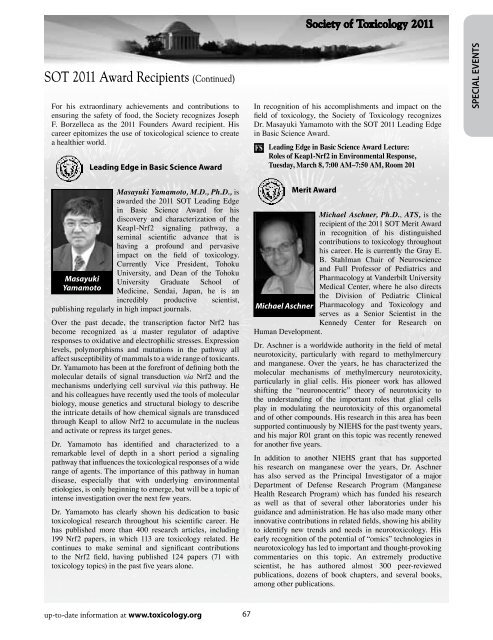Program - Society of Toxicology
Program - Society of Toxicology
Program - Society of Toxicology
You also want an ePaper? Increase the reach of your titles
YUMPU automatically turns print PDFs into web optimized ePapers that Google loves.
<strong>Society</strong> <strong>of</strong> <strong>Toxicology</strong> 2011<br />
SOT 2011 Award Recipients (Continued)<br />
For his extraordinary achievements and contributions to<br />
ensuring the safety <strong>of</strong> food, the <strong>Society</strong> recognizes Joseph<br />
F. Borzelleca as the 2011 Founders Award recipient. His<br />
career epitomizes the use <strong>of</strong> toxicological science to create<br />
a healthier world.<br />
Leading Edge in Basic Science Award<br />
In recognition <strong>of</strong> his accomplishments and impact on the<br />
field <strong>of</strong> toxicology, the <strong>Society</strong> <strong>of</strong> <strong>Toxicology</strong> recognizes<br />
Dr. Masayuki Yamamoto with the SOT 2011 Leading Edge<br />
in Basic Science Award.<br />
Leading Edge in Basic Science Award Lecture:<br />
Roles <strong>of</strong> Keap1-Nrf2 in Environmental Response,<br />
Tuesday, March 8, 7:00 AM–7:50 AM, Room 201<br />
SPECIal Events<br />
Masayuki<br />
Yamamoto<br />
Masayuki Yamamoto, M.D., Ph.D., is<br />
awarded the 2011 SOT Leading Edge<br />
in Basic Science Award for his<br />
discovery and characterization <strong>of</strong> the<br />
Keap1-Nrf2 signaling pathway, a<br />
seminal scientific advance that is<br />
having a pr<strong>of</strong>ound and pervasive<br />
impact on the field <strong>of</strong> toxicology.<br />
Currently Vice President, Tohoku<br />
University, and Dean <strong>of</strong> the Tohoku<br />
University Graduate School <strong>of</strong><br />
Medicine, Sendai, Japan, he is an<br />
incredibly productive scientist,<br />
publishing regularly in high impact journals.<br />
Over the past decade, the transcription factor Nrf2 has<br />
become recognized as a master regulator <strong>of</strong> adaptive<br />
responses to oxidative and electrophilic stresses. Expression<br />
levels, polymorphisms and mutations in the pathway all<br />
affect susceptibility <strong>of</strong> mammals to a wide range <strong>of</strong> toxicants.<br />
Dr. Yamamoto has been at the forefront <strong>of</strong> defining both the<br />
molecular details <strong>of</strong> signal transduction via Nrf2 and the<br />
mechanisms underlying cell survival via this pathway. He<br />
and his colleagues have recently used the tools <strong>of</strong> molecular<br />
biology, mouse genetics and structural biology to describe<br />
the intricate details <strong>of</strong> how chemical signals are transduced<br />
through Keap1 to allow Nrf2 to accumulate in the nucleus<br />
and activate or repress its target genes.<br />
Dr. Yamamoto has identified and characterized to a<br />
remarkable level <strong>of</strong> depth in a short period a signaling<br />
pathway that influences the toxicological responses <strong>of</strong> a wide<br />
range <strong>of</strong> agents. The importance <strong>of</strong> this pathway in human<br />
disease, especially that with underlying environmental<br />
etiologies, is only beginning to emerge, but will be a topic <strong>of</strong><br />
intense investigation over the next few years.<br />
Dr. Yamamoto has clearly shown his dedication to basic<br />
toxicological research throughout his scientific career. He<br />
has published more than 400 research articles, including<br />
199 Nrf2 papers, in which 113 are toxicology related. He<br />
continues to make seminal and significant contributions<br />
to the Nrf2 field, having published 124 papers (71 with<br />
toxicology topics) in the past five years alone.<br />
Merit Award<br />
Michael Aschner, Ph.D., ATS, is the<br />
recipient <strong>of</strong> the 2011 SOT Merit Award<br />
in recognition <strong>of</strong> his distinguished<br />
contributions to toxicology throughout<br />
his career. He is currently the Gray E.<br />
B. Stahlman Chair <strong>of</strong> Neuroscience<br />
and Full Pr<strong>of</strong>essor <strong>of</strong> Pediatrics and<br />
Pharmacology at Vanderbilt University<br />
Medical Center, where he also directs<br />
the Division <strong>of</strong> Pediatric Clinical<br />
Michael Aschner Pharmacology and <strong>Toxicology</strong> and<br />
serves as a Senior Scientist in the<br />
Kennedy Center for Research on<br />
Human Development.<br />
Dr. Aschner is a worldwide authority in the field <strong>of</strong> metal<br />
neurotoxicity, particularly with regard to methylmercury<br />
and manganese. Over the years, he has characterized the<br />
molecular mechanisms <strong>of</strong> methylmercury neurotoxicity,<br />
particularly in glial cells. His pioneer work has allowed<br />
shifting the “neuronocentric” theory <strong>of</strong> neurotoxicity to<br />
the understanding <strong>of</strong> the important roles that glial cells<br />
play in modulating the neurotoxicity <strong>of</strong> this organometal<br />
and <strong>of</strong> other compounds. His research in this area has been<br />
supported continuously by NIEHS for the past twenty years,<br />
and his major R01 grant on this topic was recently renewed<br />
for another five years.<br />
In addition to another NIEHS grant that has supported<br />
his research on manganese over the years, Dr. Aschner<br />
has also served as the Principal Investigator <strong>of</strong> a major<br />
Department <strong>of</strong> Defense Research <strong>Program</strong> (Manganese<br />
Health Research <strong>Program</strong>) which has funded his research<br />
as well as that <strong>of</strong> several other laboratories under his<br />
guidance and administration. He has also made many other<br />
innovative contributions in related fields, showing his ability<br />
to identify new trends and needs in neurotoxicology. His<br />
early recognition <strong>of</strong> the potential <strong>of</strong> “omics” technologies in<br />
neurotoxicology has led to important and thought-provoking<br />
commentaries on this topic. An extremely productive<br />
scientist, he has authored almost 300 peer-reviewed<br />
publications, dozens <strong>of</strong> book chapters, and several books,<br />
among other publications.<br />
up-to-date information at www.toxicology.org<br />
67
















